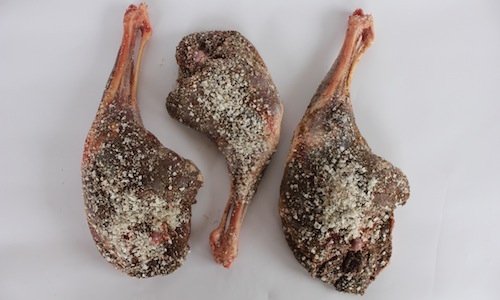11-12-2012
Venison fenalår
How to make a "ham" out of a different meat. A matter of precise hanging and dipping into fat

Venison fenalår, a Norwegian "ham" usually made with lamb. Here are the instructions to make it yourself at home
As we anticipated yesterday, curing meat is the product of cultures dealing with the problem of extending shelf life of meat by making it inhospitable to pathogenic microbes. Evidence of meat curing can be found as early as 40,000 BC in Europe in the form of cave paintings in Sicily. The earliest preservation techniques would have utilized the sun, wind, rock salt, or salt from partially reduced seawater as well as ash from certain salt rich plants to dry meat.
Partially drying meat allows the survival of only certain microbes with anti-pathogenic qualities whereas removing all water makes it impossible for the survival of any micro flora. Originally most products were made with mineral salts. The nitrous compounds contained in mineral salts help with preservation. Sea Salt (which is iodized) and in modern use is frequently mixed with nitrates to assist the process. Salt (NaCl) does not kill microorganisms but a change its surrounding’s osmotic properties. This change in the osmotic relation to the environment leads to less available water leaving less for the microorganisms to metabolize. This leads to an overall lower count of microorganisms.
In Northern Europe the ancient meat preservation techniques have used smoke to create a physical layer on the salted meat which keeps it from spoiling. In the photo above is a leg of venison onto which we have put to salt, making our version of the Norwegian Fenalår. Normally the meat used for this process is Lamb, we've chosen to experiment with different meats. Last year I made two of these ‘hams’ both of which turned out very delicious. As these were so successful I kept one of these hams way past its prime in order to use the molds and lactic acid bacteria, to inoculate this years ones.
Using wild bacteria, yeasts and molds can be a risky process, but when a successful fermentation occurs, this should always be used to inoculate the next batch.This year’s venison fenalår has also been smoked (more on this in the next post) adding an extra dimension to the flavor, and of course, over the year of meditation I have had time to adapt the recipe. As venison lacks the thick fat of pork, it must have some protection to stop it drying too much over the year, so after two months of drying it will be dipped in fat to slow the process, after a further 4 months it will be dipped in bee’s wax to completely halt its dehydration.
The recipe for our venison fenalår is as follows:
Rub a well trimmed and clean roe deer leg with yogurt whey.
Leave at 5 degrees overnight.
Rub the leg with juniper dust and salt (around 2% of weight).
Leave at 2 degrees for 7 days.
Rub the leg with spruce resin tincture.
Hang the leg at 2 degrees for four days.
Place the leg in cold smoker for 4 days.
Remove and hang for two months.
Dip into rendered deer fat.
Leave a further 2 months.
Dip into melted bee’s wax.
Leave a further 2 months.
Remove wax, slice thinly and enjoy!
P.S.: products that are designed to age for a long time are traditionally made during the cold months November or December. This allows the drying process to happen in cool temperatures, the aging process, a slow enzymatic process can then occur over the summer months to then have your cured product ready to eat thinly sliced the following winter. Now is the season, get experimenting!
Nordic Food Lab
The most interesting experiments held in the Nordic Food Lab in Copenhagen, housed, since 2009, in a boat moored in front of René Redezpi’s Noma
Born in Edinburgh, head of culinary research and development at the Nordic Food Lab, he spends his time navigating the world through his nose and mouth
Author's articles list